How much of the high end brands have sold out to China?
This second “report card” of the top clothing brands will focus on luxury brands. (Please see the first post in this series for more information on these “report cards”).
The luxury brand industry is constantly evolving, of course, For example, Polo Ralph Lauren was once thought of as a luxury brand, but in expanding their brand to appeal more to the masses they intentionally diluted a lot of their cachet. So I left them off this list (I’ll be covering them when I get to the more mass-market brands).
When I was reviewing other product categories, I noticed that in each category, there’s usually one brand that stubbornly kept its manufacturing base in its home country. KitchenAid, for example, keeps its stand mixer made in Greenville, Ohio. Le Creuset keeps its cast iron made in Northern France. Why? Because as innovators and market leaders for these product categories, they know that outsourcing to China will spell the death of the industries they innovated.
Your house is probably littered with examples of examples of how companies started by outsourcing to China and ended up decimating their entire industries as the same subcontractors that they taught to make their products learned that they could cut out the middleman after a while and sell directly to consumers. Clocks. Clock radios. Computer monitors. Toys. Stereos. The list goes on and on and on.
But luxury brands are smart. They know that while they could save a ton of money by finding a cheap China subcontractor, that move comes with risks that far outweigh the rewards, from declines in quality and quality control to use of cheap raw materials to the stigma of having their brand value eroded by funding a regime that has no respect for human dignity, human rights, fair labor practices, or the environment. They also have the benefit of a customer base that’s willing to pay a premium–and knows that it’s not just paying for the prestige of the name, but for all the care that the company uses to protect their name.
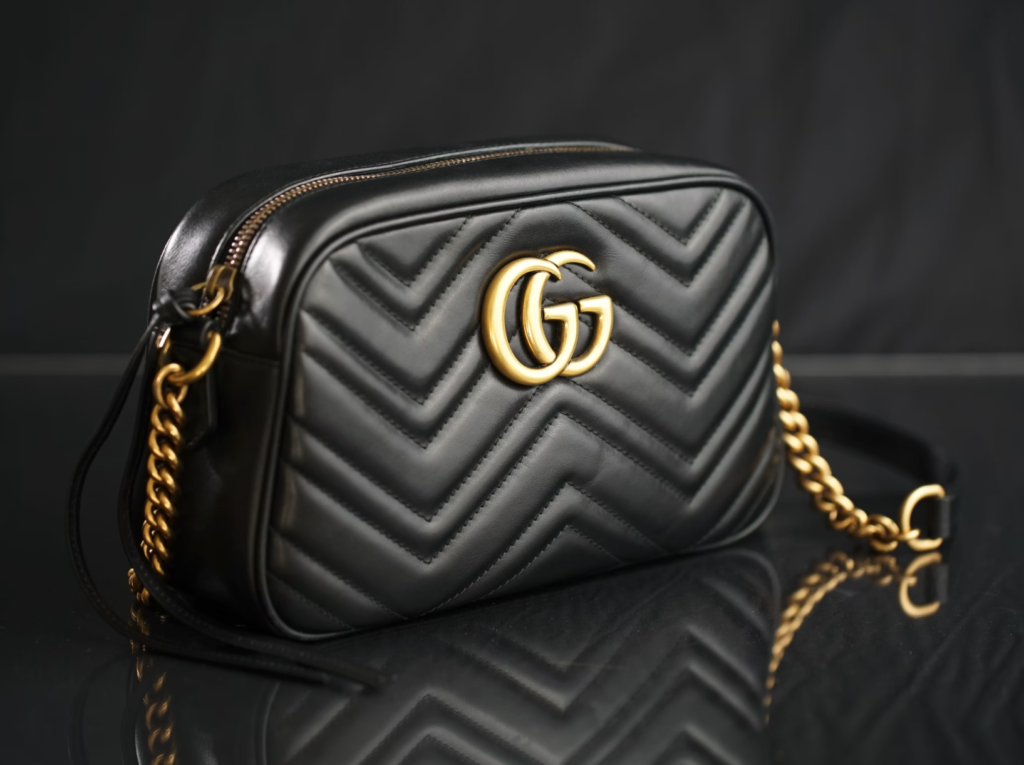
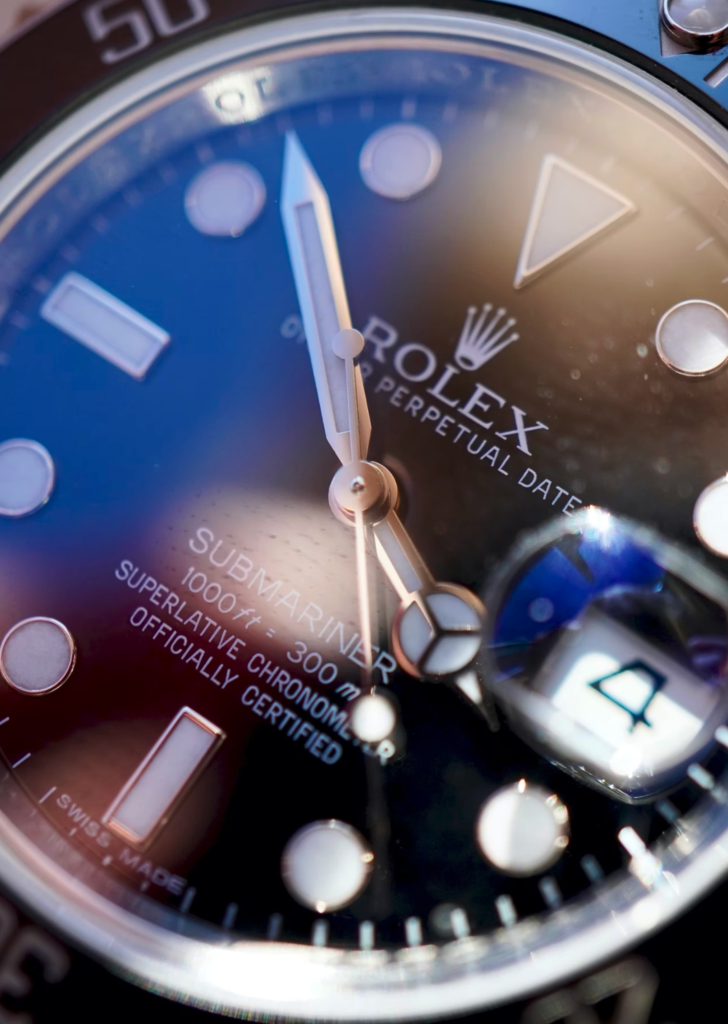
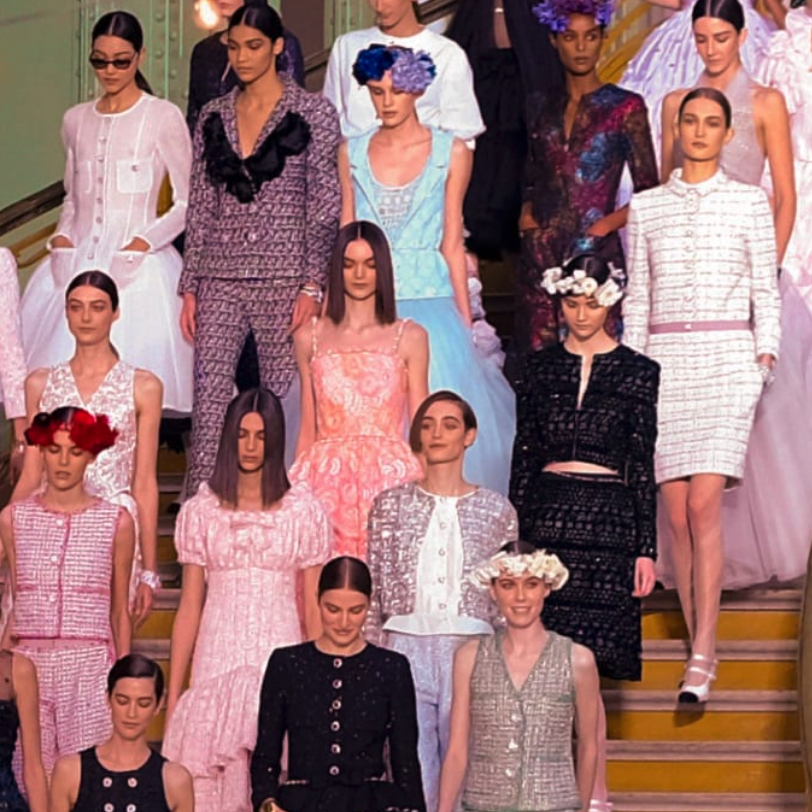
How this list was made
As I described in the introduction to these report cards, my approach here is to list out the top brands by popularity and then to give them a “letter grade” based on how much of their supply chain they allow China to monopolize AND how shameless they are in kowtowing to the China Communist Party.
To summarize, I’m going to look at the most popular clothing and footwear brands, as measured by YouGov polls and I’m going to “grade” them based on how much they are tied to China.
Luxury brands have a different problem than most other categories. Most of them fastidiously maintain production outside of China. But because their brands are sought after by the small but increasingly wealthy segment of the China population that has lots of disposable income, China manufacturers have doubled down on their efforts to counterfeit these products–and because so many other brands have given them all the production and operational know-how and access to cheap supply chains, their counterfeit products are becoming more and more indistinguishable from the original.
Best Luxury Brands Not Made in China – Quick Ranking
1. Gucci 🇮🇹 – A
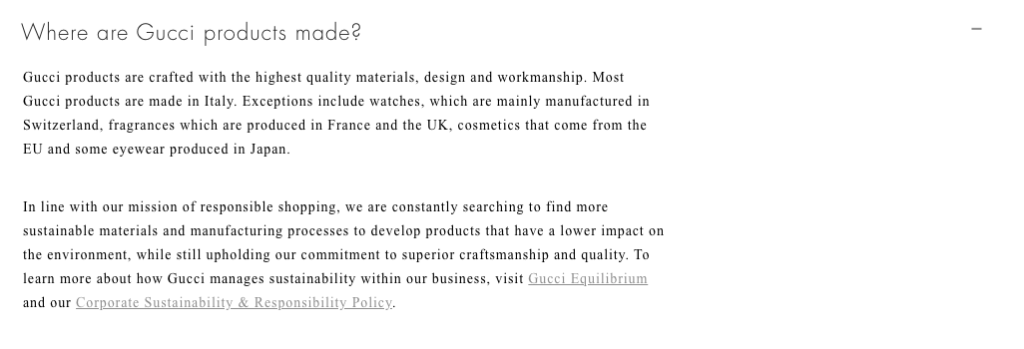
Gucci built its brand on “Made in Italy” and so they knew early on it would be foolish to outsource to China. That hasn’t stopped rumors that Gucci is secretly building components in China, but their official line is still that all of their core products are still made in Italy, specifically in a town outside of Florence called Prato that’s famous for its luxury leather goods. Even their licensed products are not made in China, a smart move on their part.
Gucci’s biggest problem is in fighting counterfeits. As Gucci’s competitors outsource to China, China manufacturers are learning all the secrets they need to know about manufacturing techniques and anti-counterfeiting measures.
Gucci’s biggest threat is that as more and more high-quality counterfeits become available on platforms like TikTok, will its audience really care? Will it become almost postmodern chic for kids to own counterfeits? Unfortunately, with the flood of China manufacturers and the blind eye of governments, time is not on Gucci’s side before its brand gets completely watered down. |
Hints for avoiding made in China: Honestly, the best way to guarantee that your Gucci bag is authentic is to go to Italy, Gucci’s Web site, or an authorized retailer like . The next best way is to look at the price you paid (if it seems too good to be true, it probably is). If you want to buy from online retailers like Amazon, make sure you’re buying from a reputable seller that you research, and make sure to get your purchase independently authenticated after you buy it.
2. Rolex🇨🇭 – A
All Rolex watches are made in Switzerland. Well, I should amend that statement. All genuine Rolex watches are made in Switzerland. But because of their high price tag and their being a status symbol, the counterfeit market for Rolexes has become an industry in itself. Amazingly, you’ll find plenty of companies with Web sites proudly advertising how they have the best fake Rolexes that are far superior than cheaply made fake Rolexes. And Rolex seems powerless to do anything about a lot of them.
And if you look at this Wired UK article, there are some knockoffs where it’s almost impossible to tell the difference unless you spend hours inspecting every tiny detail.
Hints for avoiding made in China: The only real way is to go to a Rolex store yourself, or an official Rolex retailer.
3. Chanel 🇫🇷 – A
As with Gucci, Rolex and Louis Vuitton, Chanel has been keeping manufacturing in Europe. And like them, their main challenge is fighting off rumors that they’re “secretly” making things in China and combatting counterfeiters.
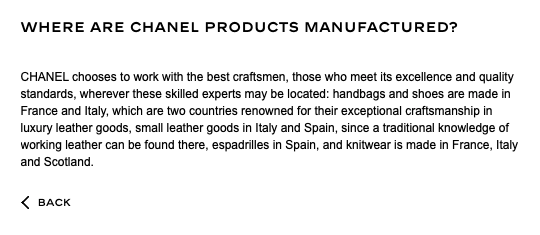
Hints for avoiding made in China: Avoid online sellers. Go to a Macy’s, Bloomingdales, Bergdoff Goodman, Saks, Neiman Marcus, or Chanel store.
4. Louis Vuitton 🇫🇷 – A
Louis Vuitton also still keeps production outside of China. When you see transparency on a company’s Web site like this, you know they “get it”. (It’s when you see nonsense like “proudly designed in USA” that you know a company has sold out its core values)
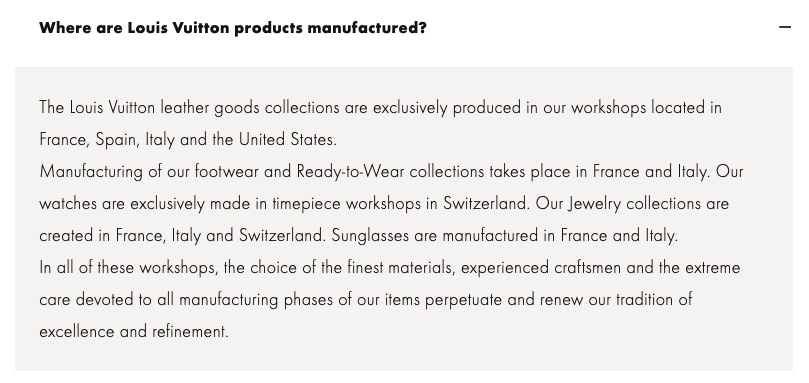
These brands have discovered something important. When you protect your brand’s integrity, your brand’s value goes up. It’s probably tempting for them to move manufacturing to China to meet the growing demand from the population of China that finds itself absurdly rich (never mind that the median annual household income is $10,410 USD a year, which would purchase just about two of these bags).
Hints for avoiding made in China: Again, go to a Louis Vuitton store, their Web site, or an authorized dealer like Saks, Nordstrom, Neiman Marcus, and Bloomingdales.
5. Prada 🇮🇹 – D
Prada is one of the first luxury brands to move a big portion of its manufacturing to China. As early as 2011, they were outsourcing at least 20% of their manufacturing to China. Head designer and granddaughter of the founder Miuccia Prada herself said in 2011 that “Sooner or later, it will happen to everyone because Chinese manufacturing is so good”.
Is this an accurate statement? Maybe. If you pay enough money to construct a factory in China, make sure it has all your manufacturing and operational techniques, and monopolizes supply chains, you can probably get some decent quality, and you can profit if you convince your customers to continue to pay Made-In-Italy prices for Made-in-China merchandise.
But at what cost? If you sell a $5000 handbag to a US consumer, and $1000 goes back to Italy, $1000 pays for your cheap labor, and the other $3000 goes to subsidize the Chinese Communist Party, who’s the winner here?
Hints for avoiding made in China: Unless you are happy paying top dollar for Made in China junk, avoid this brand and shame others to do the same.
6. Dior 🇫🇷 – B
As of 2021, Christian Dior appears to continue to manufacture virtually all its products out of Europe. Better yet, its Web site appears to clearly label the country of origin for most of its products on their product pages. It also has this FAQ.
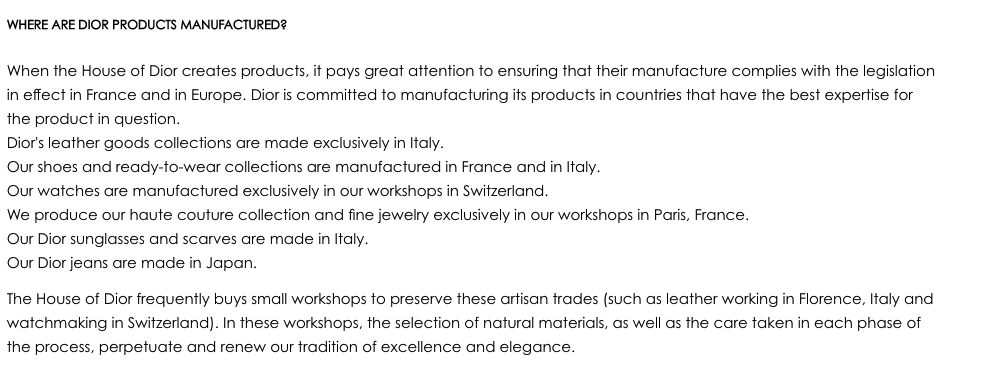
They don’t mention smaller licensed items like shirts, so check the label on those.
Dior does have a huge market in China, and so you’ll find accounts of them folding when the Weibo mobs attack them. For example, in 2019 they gave a groveling apology when one of their employees had the audacity to show a China map without clearly marketing Taiwan as a province of China. I guess I don’t blame them–it’d be nice if they stood up for the sovereignty of Taiwan, but of course the CCP would make sure that anything other than a groveling apology would shut them out of their market completely. I do notice on their Web site they say “Taiwan area/region” for customers in Taiwan, which tells me they’re toeing a very fine line (at least they’re not completely selling out and saying “Taiwan, China” like the spineless people at UPS.
7. Armani 🇮🇹 – C
Armani is another one of those companies that’s become very confusing. There’s the original Giorgio Armani line, as well as a dizzying set of other brands leveraging the name aimed at more of a mass market, such as Emporio Armani, Armani Exchange.
Not surprisingly, it’s only the high end “Georgio Armani” merchandise that’s likely to be made in Italy. So if you buy a $3000 Georgio Armani suit, chances are it’ll be made in Italy (and marked as such). But anything else, and all bets are off. Check the label.
8. Coach 🇺🇸 – F
The majority of Coach bags and wallets are made in China these days. Coach is actually owned by Tapestry, an American multinational holding company thgat also owns Kate Spade and Stuart Weitzman. Being a public company, Tapestry is of course under going to be under constant pressure to lower its costs and maximize its profits, which of course doesn’t bode well for its ability to stick to principles.
Sure enough, all of their brands are all-in with China, both in terms of the sheer amount of manufacturing that’s gone there, as well as the focus on their marketing efforts. When Coach had the temerity to imply that Taiwan is a sovereign republic (which it is) on a T-shirt, the full force of the Weibo mob came on them until they had to give a groveling apology, throwing the people of Taiwan under the bus to appease citizens of China who would never have any interest in buying their products.
One can only hope that the tariffs that the US put in place will at least convince them to diversify their supply chain–I did recently see that wallets are being made in Vietnam, which was a good sign.
But as of right now, I can’t recommend Coach or any other of Tapestry’s brands.
9. Versace 🇮🇹 – B
Versace also had its own “T-shirt-Gate” when it released its own T-Shirt implying in 2019 that Hong Kong and Macau had identities separate from China (which they do). Like Coach, they had to give their own groveling apology in order to save any chance they had of participating in the China market. The skill by which the Chinese Communist Party pulls the strings of its social media to punish anyone who speaks sacrilege against the Party is both chilling yet fascinating–it’s like Mao’s Red Guard on steroids.
In 2018 when Donatella Versace sold her brand to the Michael Kors group, she proclaimed that Versace will always produce “everything” in Italy, even t-shirts. The reality is that Versace stuff is made mainly in Italy but it’s also made in Germany, Spain, France, Switzerland, Romania, Bulgaria, and Albania.
So far it doesn’t appear that they have things made in China, but of course that can change any time.
10. Michael Kors 🇺🇸 – F
Michael Kors sources the vast majority of its stuff from China. If you look hard enough you’ll find products made in Italy, Turkey, Indonesia, the Philippines, Vietnam, and South Korea.
But the bulk of their handbags come from a subcontractor called Sitoy Group Holdings, Ltd., which also makes Coach and Prada bags. And surprise! Sitoy is now producing its own private label products where they can use the top secrets and supply chains that they received from the top brands to build their own products.
Michael Kors, along with other brands like Coach, may have profited in the short-term by moving all of their manufacturing to China, but they will also be the first to see their brands disappear.
11. Cartier 🇫🇷 – B
Cartier jewelry and watches are still made primarily in Switzerland, and its glasses and sunglasses in France and Italy. They still own their factories. As with Chanel, Louis Vuitton, and Gucci it is constantly fighting against counterfeiters. It may be a losing battle–China manufacturers have gotten good at mimicking designs down to the smallest detail. In 2020, the US Customer and Border Protection department intercepted 26,000 counterfeit goods that would have been worth $1.3 billion if they were genuine. The question is–how many did they not intercept? That’s all money going to the CCP.
Not giving them an A because they don’t explicitly state on their site where their products and–and are not–made.
Hints for avoiding made in China: Go to a Cartier store or authorized retailer.
12. Dolce & Gabanna 🇮🇹 – C
Most of Dolce & Gabanna’s products are made in Italy, but also manufactures in Switzerland, France the the UK. Their fragrances are made in Italy or Germany. Some accessories such as sunglasses are made in China.
So from a supply side they seem pretty good. But in 2018 they famously made some huge missteps when reaching out to the growing market for luxury products in China, and they have yet to recover.
In 2018, the brand launched a series of Web videos that was meant to reach out to the people of China. The video depicted a Chinese model dressed in traditional outfit attempting to eat Italian food with chopsticks.
I’ve known Italians and I’ve known Chinese people. I could see that the campaign was meant to be playful, and an over-the-top, no-filter approach that reflects Italian humor. And yet the combination of Chinese culture (which places huge emphasis on “saving face” and “showing respect”) and the CCP which demands loyalty to the Party and the Nation (which is sees as synonymous) resulted in Weibo mobs crying foul and calling the videos racist (as a Chinese person myself, I thought the videos were certainly dumb, but not racist). Dolce & Gabbana themselves recorded a video in Italian apologizing, but it was too little, too late.
Dolce & Gabbana were “cancelled” in China, where they lost 98% of their sales in China. Since then they have been trying to recover, not by trying to reach out to consumers, but by ingratiating themselves with the Chinese government.
13. Burberry 🇬🇧 – C
Outwardly, Burberry appears to have done a nice job of diversifying its supply chains. It maintains its own manufacturing facilities in the UK and Italy, and contracts out to companies in China, Poland, Romania, India, Spain, and the United States.
Most high-end coats, outerwear, and scarves will be made in England or Scotland, while most high end accessories like bags, belts, and footwear will be made in Italy.
On their Web site you’ll see country of origin for certain products, but on products where you just see the word “Imported”, this more than likely means “China”. This will be your cheaper products meant for a mass audience.
Burberry found itself the focus of the Weibo mobs when it dared to make a stand against Xinjiang cotton. The CCP pushed two celebrity spokespeople from China to cut ties with them and to publicly shame them for daring to question Xinjiang cottonor the treatment of Uyghur Muslims. Even some product placement was removed from Tencent Holding’s popular “Honor of Kings” game. Expect more of this coordinated “cancellation” as China monopolizes more and more industries.
I’m going to give Burberry a B here, only because it appears to have weathered the faux outrage over its Xinjiang statement without completely groveling like Nike did. So keep on buying them, but just check the label.
14. Hugo Boss 🇩🇪 – C
Hugo Boss also found itself between the rock of human rights activists telling them to speak out against the mistreatment of Uyghurs in Xinjiang and the hard place of the CCP and its zero-tolerance policy of any questioning of its supremacy. Similar to what Burberry did in March 2021 it placed an innocuous statement on its Web site informing its customers that it did not use cotton produced in Xinjiang.
What probably made things much worse is that an “unauthorized” person who updated their Weibo account published a statement saying “we will continue to purchase and support Xinjiang cotton”, which was quickly removed.
Hugo Boss was caught up in the manufactured backlash, with one of its China celebrity endorsers breaking her deal with them because she only want to work with companies that use cotton from that region.
Hugo Boss maintains factories in Germany, Poland, Italy, and Turkey, which produce 20% of their products. The other 80% is “sourced from suppliers around the world”, which most likely means China. They are transparent about their supplier list, which I do like to see. 26 out of 143 factories are in China (about 18%), but of course it’s hard to tell what percentage of the total production they make up.
Do you know of other luxury brands not made in China worthy of mention here? Let us know in the comments!
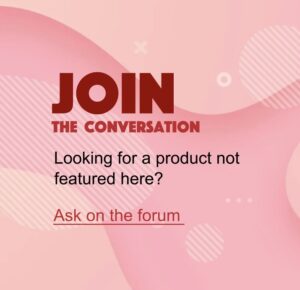
Just a note: the word you intended is “cachet”, not “cache'”. Thanks for this useful article.
Thanks Licy! Just goes to show you can show an old dog new tricks–I was an English major and decades later this is the first time anyone took the time to correct me…much appreciated! 🙂
Love it thank you! Do not want to buy anything that supports communism.
How can I get the other article mentioned in the beginning of this one? The first report card. Is there a more current one now?
Thanks Nancy. I put a link at the top of the article that links to the first article in the series (which links to this “report card” on luxury brands as well as for others on sportswear, footwear, and the most popular apparel brands).
If there are specific brands or topics you’d like me to explore and/or if you see anything in the existing articlea that you feel is outdated, please feel free to let me know here, and I’ll make a point to write or update! 🙂
Really enjoying your work. Can you please comment on Koio sneakers? Thank you!
Thank you for the research that went into this article! I’m looking at this from an animal cruelty perspective as well, so I have to generally assume that any leather product coming out of China has probably been skinned alive, whereas I’m hoping that the leather that comes from Europe animals is held to a higher standard for how they are allowed to treat them. Do you think that’s a safe assumption?
Hi Allyson,
Unfortunately, the conversion on this topic is dominated by activists who hold extremist views (most of the sites I found say that someone is “cruel” if they eat animals, use animal hides, or even recycle products made with animal hides). What I wish these groups would realize is that if they just tried to find a middle ground, they could save a lot more animals from suffering. As it is, their shouting at the wind does nothing but boost their own egos and annoy everyone.
I’d suggest Googling terms like “ethically sourced leather”. Once you get past the sites that scream and shout that there’s no such thing, you’ll find some really interesting sites. For example, this company that produces computer bags works in India (where cows are sacred) and work in partnership with Hindu farmers to source hides from cows that pass naturally.
https://www.mac-case.com/blogs/news/ethically-sourced-leather-vs-vegan-leather
Parker Clay says that their leather is “sustainable”, meaning that its leather (from Ethiopia) is from cows that are treated with “care and respect”.
https://www.parkerclay.com/pages/sustainable-leather
Of course, it’s impossible to tell what’s clever PR and what’s reality.. But generally, I think of one rule-of-thumb. The cheaper something is and the more mass-produced it is, the better the chance that the “lowest bid” manufacturer that the brand chose cut corners to achieve their low bid. And that may very well mean that animals were mistreated.
Another rule of thumb I use–and this can apply to “No to China” as well as “No to Animal Cruelty”–what a brand DOES NOT say speaks just as loud (maybe louder) than what they DO say. If I see a brand say “proudly designed in California”, I know immediately it was made in China. Similarly, if you’re looking to buy a brand, call them and see if they even pay lip service to ethics with animal treatment. If not, you probably have your answer there.
So unfortunately, I’m not sure if just because something was made in Europe that’s a sign that animals weren’t mistreated. I’d suggest finding a brand you like and then researching. That’s another thing these animal activist groups need to realize–screaming and shouting never helps, but if enough consumers calmly and respectfully ask questions and make buying decisions based on the answers, the brands will get the hint.
I’ve worked in the high fashion industry in Italy and Japan for several years. It’s sadly borderline impossible to avoid China. Prato is where cheap Italian fashion is made, many companies have been bought by Chinese and operate with imported Chinese workers at basically slave prices(I’m assuming thats how the counterfeit appear). They can still use the made in Italy name due to the location even thought it’s a 100% a Chinese operation. Como, where higher quality industrial made in Italy products are made, now imports most of it’s fabric or threads from China. If 3 or more steps of production are done in Italy it can be called “made in Italy”. Many historical companies have shut down or have moved their production and Italian workers to China as supervisors. Unfortunately Italy made a huge mistake and lost the knowledge of its trades. What really made “made in Italy” a brand was the superior craftsmanship, industrialization made all that disappear. Now only very few can make excellent quality products but at a hefty price. Japan is much the same lots of Vietnamese and Chinese “interns”
(cheap Workers) work in Japanese factories or products are being shipped out to have partial finishes made in China. Beware of anything that says “ imported “ on fancy websites, that means made in China, anything to camouflage the true origin and make dumb people pay thousands for products that are worth 10$. To me this is the most irritating thing, cheap quality, cheap materials with astronomic prices and false advertising basically because those made in Italy or Japan mean almost nothing.
I believe all Ferragamo products are still made in Italy. Thank you for this article!
There is a great article about Prato, Italy from the New Yorker. It has been taken over by subcontracted factories with Chinese workers. They are making a lot of the Italian designer handbags. So if I hear Prato, I already know that it is made by very low wage workers. It’s really disgraceful. They are terribly exploited.
Here is the article.
https://www.newyorker.com/magazine/2018/04/16/the-chinese-workers-who-assemble-designer-bags-in-tuscany
Very interesting—and disturbing—read. Thanks for sharing, Lisa. It’s a good reminder that the Chinese communist system would not be thriving if they were not embraced by Western capitalists who are all too willing to exploit the promise of cheap and exploited labor.
And that the ones who are enabling the Western capitalists are none other than ourselves, the consumers.
The one area I take a little hope is that these immigrants from China to Italy do at least have a hope to experience and embrace freedom (and if not them, then their kids). That’s more than their counterparts back in China can say.
Would this list be able to be cross-referenced with non-Nazi history and non-genocide history as well, to assist buyers who want to shop guilt and blood-free?
Thanks for the question. It’s a good one.
If you search on the Web, there are lots of sites that discuss companies that helped the Third Reich. Of course, there were German companies like Bayer, BMW, Chanel, Deutsche Bank, Hugo Boss, Mercedes-Benz, Merck, Porsche, and Volkswagen, among many others.
As evil as it was, it’s understandable why German companies supported their government. German citizens didn’t have a choice. Those who did were punished or executed. Those who went about their lives as normal were “rewarded” by being allowed to live in quiet obscurity.
What’s less understandable are American companies that supported Nazi Germany, including the Associated Press, Ford, General Motors, and IBM. These companies DID have a choice, and they chose profits over principles.
The parallels with today are chilling. Unlike the Third Reich, which took the world by surprise in 1933, the Communist Party of China has a history of tyranny that mirrors everything that Nazi Germany did, from wiping out entire ethnic groups in Xinjiang, to a surveillance state that Himmler could only dream about, to propaganda operations that put Goebbels to shame, to threatening their neighbors. From internment camps (re-education camps) to Hitler youth (Red Guard) to punishment of those who speak against the state, the markers of tyranny are clear.
The difference, of course, is that while people only had 6 years to observe Hitler’s Germany, we’ve had 75 years to observe the CCP. And while a handful of American companies and their customers supported Nazi Germany, American politicians, corporations, and consumers STILL throw money at China. If China is foolish enough to invade Taiwan as Hitler did Poland, there are a lot of Americans who will have blood on their hands.
I remember my dad (who like most people in China suffered at the hands of Imperial Japanese brutality during the War) refused to buy any Japanese products. But after a while (helped by the fact that he went through about five American cars that all broke down within a year), he finally bought a Toyota (which lasted 12 years). He never forgot what the Japanese did, and I doubt he forgave them. But he realized that the war was over and Japan had learned its lessons.
The CCP, on the other hand, has never paid for its crimes against 80 million of its own people. To the contrary, Nixon and Kissinger in their folly rewarded them.